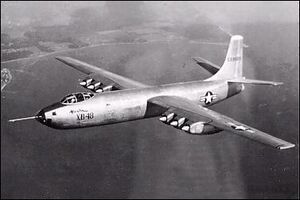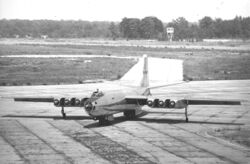Engineering:Martin XB-48
| XB-48 | |
|---|---|

| |
| Role | Bomber |
| Manufacturer | Glenn L. Martin Company |
| First flight | 22 June 1947 |
| Status | Canceled in 1948 |
| Number built | 2 |

The Martin XB-48 was an American medium jet bomber developed in the mid-1940s. It competed with the Boeing B-47 Stratojet, which proved to be a superior design, and was largely considered as a backup plan in case the B-47 ran into development problems. It never saw production or active duty, and only two prototypes, serial numbers 45-59585 and 45-59586,[1] were built.
Design and development
In 1944, the U.S. War Department was aware of aviation advances in Germany and issued a requirement for a range of designs for medium bombers weighing from 80,000 pounds (36,000 kg) to more than 200,000 pounds (91,000 kg). Other designs resulting from this competition, sometimes nicknamed "The Class of '45", included the North American XB-45 and the Convair XB-46. Production orders finally went to the North American B-45 Tornado, and even this airplane served only for a couple of years before again being replaced by the much more modern Boeing B-47 Stratojet, although the B-45 had the inherent performance – especially if it was not burdened with a payload – for it to then serve as a reconnaissance aircraft.[citation needed]
All of the bombers comprising the Class of '45 were transitional aircraft, which combined the power of turbojets with the aeronautical knowledge of World War II.[citation needed] The XB-48 was no exception, as its round fuselage and unswept wings showed a distinct influence of Martin's B-26 Marauder medium bomber. Still, where the B-26 had enough thrust with two massive 18-cylinder radial engines, the XB-48 needed no less than six of the new jet engines.
At the time of the XB-48's design, jet propulsion was still in its infancy. And, although it appeared superficially to have six separate engine nacelles – that is, three under each wing – the XB-48 actually had only two, unusually wide, three-engined nacelles. Each of these large nacelles also contained an intricate set of air ducts that constituted the engines' cooling system.
The XB-48 was the first aircraft designed with bicycle-type tandem landing gear, which had previously been tested on a modified B-26. The wing airfoil was too thin to house conventional landing gear mechanisms.[2] The main landing gear was in the fuselage and small outriggers located on each wing were used to balance the aircraft.
Operational history
The XB-48 made its first flight on 22 June 1947, a 37-minute, 73 mi (117 km) hop from Martin's Baltimore, Maryland plant to NAS Patuxent River, Maryland, but blew all four tires on its fore-and-aft mounted undercarriage on landing when pilot Pat Tibbs applied heavy pressure to the specially-designed, but very slow to respond, insensitive air-braking lever. Tibbs and co-pilot Dutch Gelvin were uninjured.[3]
Specifications (XB-48)

Data from "Encyclopedia of US Air Force Aircraft and Missile Systems, Volume II"[4]
General characteristics
- Crew: three (pilot, co-pilot, and bomber-navigator)
- Length: 85 ft 9 in (26.14 m)
- Wingspan: 108 ft 4 in (33.02 m)
- Height: 26 ft 6 in (8.08 m)
- Wing area: 1,330 sq ft (123.5 m2)
- Empty weight: 58,500 lb (26,535 kg)
- Gross weight: 92,600 lb (42,000 kg)
- Max takeoff weight: 102,600 lb (46,540 kg)
- Powerplant: 6 × General Electric J35 axial flow turbojet, 3,820 lbf (17.0 kN) thrust each
Performance
- Maximum speed: 454 kn (523 mph, 841 km/h) at 35,000 ft
- Cruise speed: 361 kn (415 mph, 668 km/h)
- Range: 1,566 nmi (1,802 mi, 2,900 km)
- Combat range: 691 nmi (795 mi, 1,280 km)
- Service ceiling: 39,400 ft (12,009 m)
- Rate of climb: 4,200 ft/min (21.3 m/s)
Armament
- Guns: 2 × .50 in (12.7 mm) M-2 machine guns in tail turret (proposed)[2]
- Bombs: 1 × 20,000 lb (9,980 kg) or 36 × 250 lb (113 kg)
See also

Aircraft of comparable role, configuration and era
- Boeing B-47 Stratojet
- Convair XB-46
- English Electric Canberra
- Ilyushin Il-22
- Ilyushin Il-28
- North American B-45 Tornado
Related lists
- List of bomber aircraft
- List of military aircraft of the United States
References
Notes
- ↑ "Fact Sheet: Martin XB-48." National Museum of the United States Air Force. Retrieved: 5 July 2010.
- ↑ 2.0 2.1 Jones 1969
- ↑ Mizrahi 1999, pp. 50–52.
- ↑ Knaack, Marcelle Size. Encyclopedia of U.S. Air Force Aircraft and Missile Systems: Volume II: Post-World War II Bombers, 1945–1973. Washington, DC: Office of Air Force History, 1988. ISBN:0-16-002260-6.
Bibliography
- Ginter, Steve. Martin XB-48.Simi Valley, California: Steve Ginter Books, 2022. ISBN:979-8-9854726-9-1
- Jones, Lloyd S. U.S. Bombers, B-1 1928 to B-1 1980s. Fallbrook, CA: Aero Publishers, 1962, second edition 1974. ISBN:0-8168-9126-5.
- Mizrahi, Joe. "The Last Great Bomber Fly Off". Wings, Volume 29, Number 3, June 1999.
External links
- Encyclopedia of US Air Force Aircraft and Missile Systems, Volume II
- National Museum of the Air Force
- GlobalSecurity.org
- Film footage of the Martin XB-48
 |

